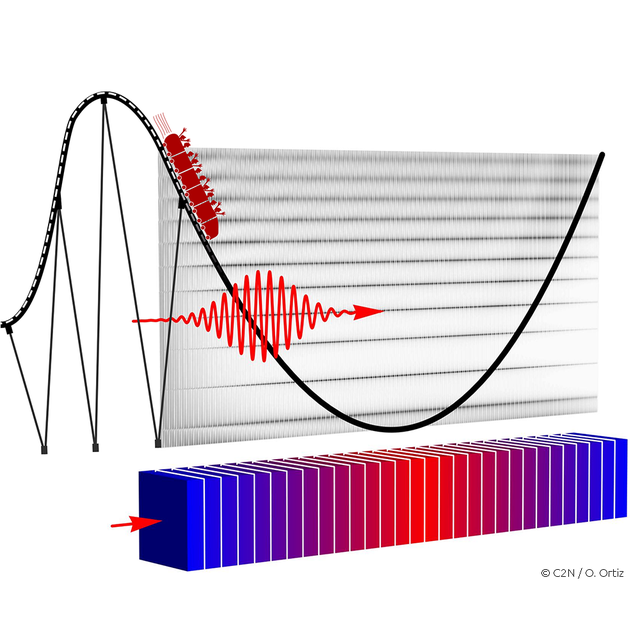In a theoretical work, a team of researchers at C2N has proposed a novel nanoengineered approach to manipulate the way acoustic-phonons travel through a periodic structure. They have demonstrated that their phononic platform allows studying a variety of potentials landscapes.
By controlling the propagation of sound at the nanoscale, nanophononics presents a promising simulation platform for the study of single particles trapped in quantum wells, interatomic molecular dynamics, and, in general, potentials. Like a ball falling a hill or a rollercoaster going through its loops, potentials govern the dynamics of a variety of physical systems. The challenges to experimentally study these dynamics vary depending on the system’s nature. In contrast to optical platforms, phonons at the nanoscale feature slow speed of propagation and long coherence length at extremely small wavelengths (~10nm). It allows the study of wave dynamics in quasi-infinite systems on timescales well below the oscillation period. For nanoacoustics, periodic structures are commonly used for the implementation of devices including phonon mirrors and cavities. They are built stacking identical pairs of semiconductor material layers. Using these devices, simulate coherent wave propagation in one-dimensional potentials becomes feasible. Earlier implementations using acoustic phonons with gigahertz-terahertz frequencies were based on coupled nanoacoustic resonators.
In a theoretical work published in Physical Review B (chosen as an “editor's suggestion”), a team of researchers at the Centre de Nanosciences et de Nanotechnologies – C2N (CNRS / University Paris-Saclay), have proposed a novel strategy to implement effective potentials for sound. By altering the design of a periodic structure, they have demonstrated that different potentials landscapes can be reproduced and investigated.
The theoretical framework to engineer effective potentials is based on the dispersion relation of phonons in a periodic superlattice, a structure composed of unit cells made of two layers (AlAs and GaAs). Instead of stacking identical pairs of layers, the C2N team slightly changed the configuration of consecutive cells, breaking the periodicity of the structure in the process. This slight but significant change opens the door to shaping the way phonons travel through the nanoengineered structure. By tuning the parameters defining each pair in the structure, effective phononic potentials are designed. To demonstrate the versatility of this approach the authors applied this method to several textbook potentials, and study the resulting stationary modes. This new design feature works in extremely high frequencies (hundreds of gigahertz) while remaining achievable by standard fabrication techniques.
The proposed structures can be experimentally investigated through all-optical techniques like pump-probe and Raman spectroscopy. The reported phononic platform allows studying potentials that are impossible or extremely challenging to measure in optical or electric analogs.
References:
Phonon engineering with superlattices: Generalized nanomechanical potentials,
O. Ortíz, M. Esmann, & N. D. Lanzillotti-Kimura
Physical Review B - Editor's suggestion (2019)
DOI: https://doi.org/10.1103/PhysRevB.100.085430
- Centre de Nanosciences et de Nanotechnologies - C2N (CNRS / Université Paris-Saclay)
Contacts:
- Omar Ortiz, PhD Student at C2N
- Daniel Lanzillotti-Kimura, CNRS researcher at C2N
Figure : Like passengers subject to the ups and downs of a rollercoaster, phonons can experience potentials as well. By altering the design of a periodic structure, effective phononic potentials are shown to be feasible. Copyright C2N / O. Ortiz & al.









